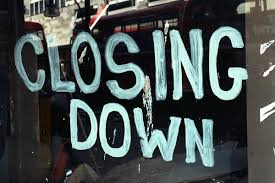 One of the five most common reasons that individuals living in Minneapolis might choose to file bankruptcy is as the result of a failed, or failing, business. Given the state of the economy over the past several years, many small business owners are struggling to continue to operate their businesses. Many of those business owners then begin to wonder what their options are regarding their financial struggles. One common question is whether a “business bankruptcy” is a good option.
One of the five most common reasons that individuals living in Minneapolis might choose to file bankruptcy is as the result of a failed, or failing, business. Given the state of the economy over the past several years, many small business owners are struggling to continue to operate their businesses. Many of those business owners then begin to wonder what their options are regarding their financial struggles. One common question is whether a “business bankruptcy” is a good option.
What are the available “business bankruptcy” options?
The term “business bankruptcy” may be misleading to many business owners. There are generally two types of bankruptcies that business entities can file, Chapter 7 or Chapter 11. However, for the average small business neither of these options are particularly helpful, or even possible, as explained below.
Chapter 7 bankruptcy is the most commonly filed bankruptcy, and could be an option for a business owner who is no longer able to operate his or her business. A chapter 7, or liquidation bankruptcy, would simply be a liquidation of the business’ current assets by the Chapter 7 Panel Trustee assigned to the case. Once the bankruptcy is filed, the Trustee would control the assets of the business, and then sell them and pay the proceeds to the creditors. The end result would be shutting down the business.
Alternatively, a Chapter 11 bankruptcy could enable a business owner to reorganize the debt of the business into manageable payments allowing the business to continue to operate. Along with filing a petition and schedules of the business’ debts and assets as in a Chapter 7, the business owner would also submit a repayment plan indicating how each creditor would be treated were the Chapter 11 to move forward. The creditors would then have the opportunity to comment on the plan and ultimately decide whether or not it is feasible. If the plan is accepted, the business would be allowed to continue running as usual while making the agreed upon payments on the Chapter 11 payment plan. Due to the fact that Chapter 11 bankruptcies typically require a large amount of revenue and are quite expensive to undertake, Chapter 11 bankruptcies are rarely filed for smaller businesses and definitely are not geared toward the small business owner. Chapter 11 is typically used by larger business as a way to cut costs and continue operation, think Blockbuster (before it filed for Chapter 7) and American Airlines.
So what can the average small business owner with a failing business do?
For the average business owner who is looking at closing his/her business and would like relief from the financial burdens, the answer is typically a personal bankruptcy (Chapter 7 or Chapter 13). Unlike with large corporations, in most cases, the small business owner has been asked to sign personal guarantees for most of the business debts. This means that although the debt is incurred for the purposes of establishing or maintaining a business, the small business owner is personally responsible for the debt. The personal guarantees mean that even if the business owner were to file a bankruptcy for the business (of the types discussed above), that would not eliminate the personal liability, and it would then follow the business owner. The only solution to the problem of the personal guarantee, other than paying the debt, is to file a personal bankruptcy.
If the business owner is planning to close the business down, a Chapter 7 is usually the perfect tool. The business would be listed as an asset on the bankruptcy schedules and all of the assets and debts of the business would also be accounted for. The bankruptcy discharge received through the personal Chapter 7 would then eliminate any personal liability for the business debt. (However, it is important to note that the personal bankruptcy does not eliminate the liability that the business with respect to any of its debts, but neither would a business bankruptcy, because businesses are not entitled to discharges as a result of bankruptcy filings).
On the other hand, if the debtor is interested in eliminating debt, but still wants to continue to operate the business, a Chapter 13 bankruptcy may be the better solution. In order to file a Chapter 13, the business owner would need to be able to make monthly payments for a period of three to five years, but at the end of the bankruptcy, may be able to continue operating the business. Whether a Chapter 13 would be an option is determined on a case by case basis.
If you are a business owner in Minneapolis, the Metro Area, or Greater Minnesota, that is struggling to continue operation of your business and interested in discussing the solutions, please contact Kain & Scott and we will be happy to speak with you regarding the available options. We have many years of experience in guiding small business owners through the bankruptcy process and our only goals are to get rid of your debt and help you get your life back.
When the time is right, or when you are ready, reach out to Minneapolis, Minnesota’s Nicest Bankruptcy Law Firm.
Kain & Scott, P.A.
100 South 5th Street #1900
Minneapolis, MN 55402
(612) 843-0527
info@kainscott.com



